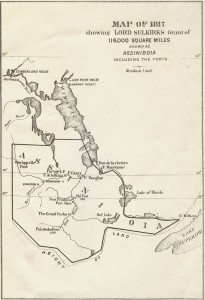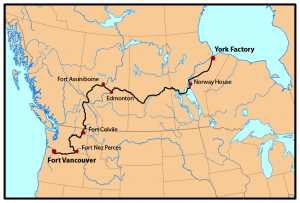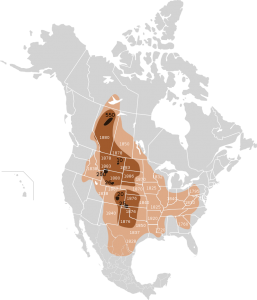8.10 The New HBC and the New Nation to 1860
In the days and months after Seven Oaks, the colony at Red River was more divided than ever. The Métis under the leadership of Cuthbert Grant had taken an important step toward becoming a self-aware and tightly knit nation in their own right. Their allies in the NWC (and their head office in Montreal) were buoyed by the apparent weakness of the HBC and its bothersome colony. The HBC, on the other hand, had the support of the British government; the death of Governor Semple hardened their commitment to the HBC.

Some resolution was achieved in the Treaty of 1818, a lesser-known agreement that came to have a lasting impact on the shape of Canadian history. Also known as the Anglo-American Convention, it tidied up a few issues left outstanding from the Treaty of Ghent (1814). Specifically, it addressed the issue of boundaries in the West. The treaty makers drew a straight line across the continent along the 49th parallel from Lake of the Woods to the Columbia River. The United States ceded to the British some territory in what is now southern Alberta. More critically, the Red River Colony lost its southern drainage and the important village of Pembina; the lands of the Red River Valley — the homeland of the Métis — were thus partitioned.
Geopolitical change told only part of the story. The year 1818 saw the return of plagues to the Prairies, accompanied by famine and armed conflict over diminished resources. Severe climate change and fluctuations aggravated matters. Massive demographic disasters ensued and the fur trade came close to a total collapse.
These new conditions set the stage for the merger of the Hudson’s Bay Company and the North West Company in 1821. The merger was both an act of desperation and an inspired reorganization.
Merger: HBC
Despite the distances involved in freighting trade goods from Montreal to the West and back again over land and by rivers and lakes, the NWC was arguably the stronger company in 1816. By 1818, however, some rot was beginning to show. Disaffection with the Montreal leadership was leading to desertions to the HBC and American competitors. The arrest and trial of several NWC employees and allies for the murder of Semple turned out badly for the HBC — everyone charged was acquitted and an independent investigation concluded that the HBC’s people fired the first shot. A counter case against Lord Selkirk demoralized the colony’s leader and he died in 1820 at 49 years of age. The British government was exasperated by the fur trade wars and insisted on a merger. Selkirk’s death, confusion at the head office of the NWC, and general battle fatigue among the wintering partners cleared the way for a single monopoly. In 1821 the companies became one: the NWC disappeared, redundant posts were dismantled, pensions were issued, and the NWC’s business model of shareholding traders became the norm in the new HBC.
The appointment of Sir George Simpson as governor of the HBC in 1822 brought significant changes. Simpson’s style was autocratic and it took time for him to win the support and (as an outsider) respect of the traders in the field. Many of the former NWC employees remained rightly mistrustful of the HBC. Simpson initially regarded with contempt the Canadiens he inherited from the NWC and sought their dismissal. Two years later, after observing the usefulness and work ethic of the Canadiens, his opinion softened somewhat. He did, however, limit the possibilities for promotion for Canadiens and Iroquois.
One of Simpson’s other initiatives was the York Factory Express (also called the Columbia Express), a route that connected York Factory to Fort Vancouver by combining the assets and knowledge of the two former competitors. The 4,000-plus kilometre route combined the use of York boats — heavy, wide draught wooden dinghies with sails — and horse brigades. The York boat fleet travelled between Hudson’s Bay and the foothills of the Rockies along the North Saskatchewan River, a route that included heavy and awkward portages that looked nothing like the days of birchbark canoes. Between the mountains and the sea the Express made use of ponies set out along well-developed brigade trails (many of which are highway routes today).

A growing American presence south of the 49th parallel, however, compromised the monopoly. New limitations on the trade in liquor in Rupert’s Land and Assiniboia created a vacuum into which American whisky traders moved. This was how American and Métis traders in the southern half of the bisected Selkirk Colony encouraged the diversion of furs away from the HBC. Efforts to stamp out these “free traders” would culminate in the trial of Guillaume Sayer (ca.1801-1849).
An NWC employee in his youth, Sayer spent much of the 1820s and 1830s working for the HBC. In 1849 he was caught trading furs to Americans at Pembina, formerly part of the Selkirk Colony. Sayer’s trial at Upper Fort Garry (Winnipeg) became a major public event. It was bound up in public resentment toward the monopolistic HBC and, also, in the ideal of Métis liberty. Sayer’s cause was taken up by Louis Riel Sr., a Métis whose fame would be eclipsed one day by his son and namesake (a mere five years old at the time of the trial). Under Riel Sr.’s leadership and encouragement, the Métis gathered in large numbers at the fort’s courthouse, demanding a fair trial for Sayer. Although he was found guilty by a jury of his peers, the judge — Adam Thom — was intimidated by the armed crowd outside. He decided not to sentence Sayer and gave him back his freedom (which he enjoyed for three months and then died). The trial’s outcome was a signal that the Company’s monopoly was broken and it was a further advance in the formation of a national consciousness among the Métis. Riel Sr.’s fame arising from the trial would serve his son well.
Grand Couteau
Two years after the Sayer Trial, a battle between the Sioux and the Métis fixed the reputation of the latter as a fighting force deserving respect. The annual (sometimes biannual) Métis bison hunt had grown in size and efficiency since the late 18th century. By 1851, however, the bison herds were shrinking. Overhunting and the westward migration of Aboriginal peoples pushed along by the arrival of American settlers below the 49th parallel were wearing down the bison numbers. The Lakota Sioux determined to reduce European predations on what they regarded as their herds. From a Sioux perspective, as well, the Métis were not observing basic conservationist principles. Pemmican continued to be produced at surplus rates in the 1840s and 1850s even as a market for bison robes and hides was opening up. Métis exploitation of the bison as a commercial resource to complement their slowly advancing agricultural settlements to the north no doubt impacted the herd populations in the eastern and central plains.
Grand Couteau, a plateau in central North Dakota, has multiple layers of significance for North American history. It was the site of the first major conflict between an Aboriginal people and the Métis. Both laid claim to the right to hunt herds, the Métis appropriating a European notion of property (that is, livestock that are not fenced in cannot be said to “belong” to anyone in particular) while sustaining a Plains hunting culture very similar to that of the Sioux. Both the Sioux and the Métis arrived at Grand Couteau in armed and mounted cavalry formations. The Métis, moreover, had an advantage in the form of Red River carts that could be flipped up or on their side to provide cover from sniper fire. Both were tightly organized and capable of showing incredible cool under fire. What’s more, the Métis bison hunting parties had evolved into very large endeavours. (There were said to be more than a thousand participants and a similar number of carts heading to Grand Couteau, although not all were present at the battle.) Managing those numbers meant that military discipline was the norm. It was, as well, potentially brutal and sometimes remorseless. Against this were 2,000 Sioux warriors in the field that day in early July 1851 when Sioux scouts encountered outriders from one of three Métis hunting parties. The end effects proved significant to both parties.
The Métis emerged victorious, their discipline and philosophy of sacrifice to the needs of the larger community vindicated; their confidence was high and Grand Couteau would stand for many years as a symbol of their potential.[1] For their part, the Sioux fared less well and would adopt different strategies for survival in a world of shrinking resources, the most immediate of which was signing their first treaty with the United States a mere two weeks after Grand Couteau.
As for the bison, their numbers continued to shrink. Grand Couteau was, in this regard, a case of closing the metaphorical bison pen after the last buffalo had bolted. As the map in Figure 8.22 indicates, the herds were hunted out of the Dakotas and southern Manitoba until what little was left could be found in the borderlands of Alberta and Montana in the late 1860s.

Key Points
- The Treaty of 1818 began to give shape to what emerged eventually as Western Canada. It also bisected the Red River Settlement, the Métis communities, and the Blackfoot Confederacy, among others.
- Exhausted by battle and legal wrangling, the HBC and NWC merged in 1821.
- The Sayer Trial of 1849 spelled the end of the HBC monopoly in trade and opened commerce across the West.
- The Battle at Grand Couteau signalled the rise of the Métis as a militarized force on the Plains and the coming crisis of shrinking bison herds.
Attributions
Figure 8.20
Selkirks land grant (Assiniboia) by J Hazard is in the public domain.
Figure 8.21
York-Factory-Express by Pfly is used under a CC-BY-SA 4.0 International license.
Figure 8.22
Extermination of bison to 1889 by Cephas is used under a CC-BY-SA 3.0 license.
Long Description
Figure 8.22 long description: Originally, bison could be found throughout almost the entire United States and up into Alberta, Saskatchewan, Southern Manitoba, and southern Northwest Territories. However, by 1889, the bison numbered no more than 800 and could only be found in a few locations. [Return to Figure 8.22]
- Irene M. Spry, “The métis and mixed-bloods of Rupert’s Land before 1870,” The New Peoples: Being and becoming Métis in North America, Jacqueline Peterson and Jennifer Brown, eds. (Winnipeg: University of Manitoba Press, 1985), 95-118. ↵

